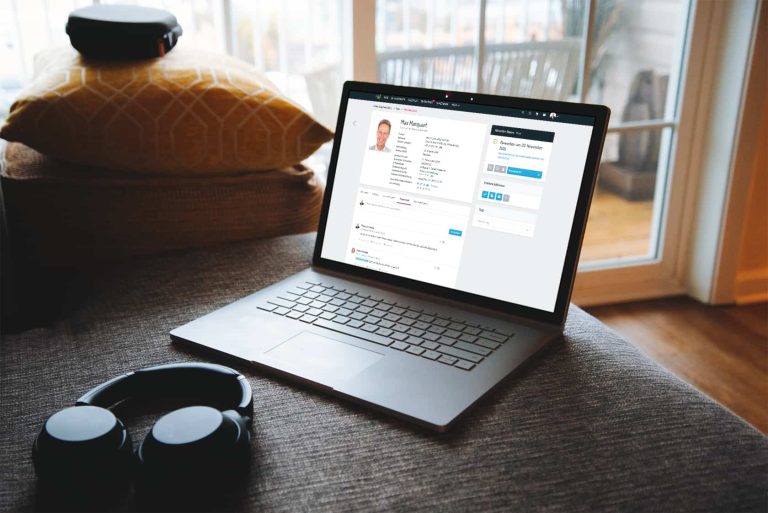Practically overnight, many companies have sent their employees to work from home, including their recruiters. They are now switching to remote recruiting, i.e. recruiting from home. We have put together a few tips on how to make this work as smoothly as possible.
A survey by the Institute for Competitive Recruiting (ICR) revealed: More than one in two recruiters (50.7 per cent) report that the number of applications has either remained the same, increased or even strongly increased, even in the current challenging situation. This shows: Recruiting is not standing still in many companies. Recruiters can build up good contacts to candidates in these times and fill vacancies quickly after the crisis.
Voting on a candidate from home – how is that supposed to work?
Recruiting is teamwork – there’s no change in that. And now everything has to be organised from home. That raises questions: How, for example, is the coordination on a candidate supposed to take place if the recruiting team is not at the same location but kilometres away from each other?
For this to succeed, the colleagues involved must, above all, organise themselves well. Functioning communication is the be-all and end-all. Because without the right level of exchange, there is a great danger of working at cross purposes instead of with each other.
What helps:
- Regular meetings should be maintained.
- To ensure that the human factor does not fall by the wayside, it is advisable to hold these as video conferences.
- Meanwhile, chats are suitable for short-term exchanges in groups or from team member to team member.
- Things that take a little longer can be exchanged by e-mail.
Exchange: Always in flux
Important: Communication in the recruiting team should never stand still. Otherwise processes get bogged down. Recruiters can take on the role of project manager – just as they would in the office.
To do this, you should always initiate digital communication in the team and actively exchange information with your colleagues, regularly share updates with them, ask questions and also remind them here and there about tasks. If you set a good example and communicate openly and transparently, you will encourage your colleagues to do the same.
Recruiting from home: avoid document chaos
However, it is not only important that all coordination processes are structured, but also that they are optimally documented and filed. For example, recruiting teams that repeatedly send documents and Excel lists back and forth in different versions via Outlook are likely to lose track of them at some point. Tip: Instead, store your documents in a cloud. The decisive advantage: everyone then works in one and the same document. Such uniformly designed processes take on a completely different significance and weighting than in the classic office routine, especially when you work from home.It is even easier if all recruiting workflows can be processed in a uniform system. From the job advertisement to the communication, the coordination among colleagues to the final acceptance. Modern applicant management software can do just that.In this, recruiting managers appoint a recruiting team for each vacancy to be filled. Using a role concept, each person in charge can access the information about an applicant and the application process that he or she is allowed to access from a data protection perspective. At the same time, each team member receives individual rights and can intervene in the process in the areas intended for them. For example, not everyone is allowed to send messages or even accept or reject a candidate.Software-as-a-service solutions offer a great “home advantage”. The corresponding applicant management software runs on the provider’s servers and is made available to customers via the cloud. The servers on which softgarden runs are located in Germany and have been awarded for their special security. Recruiting teams can access the software from anywhere and at any time. No problems arise from the use of different versions, as the latest version of the programme is always made available and used.
How to design your workflows
Once an application has been received, recruiters can use an integrated algorithm in the applicant management system to compare how well an applicant fits a position. All those responsible can call up the respective results and the application documents of the individual candidates in the tool and evaluate them again individually: the talent fits or does not fit.
Once the decision has been made who should be invited to a job interview in the next step, the recruiter sends an invitation for a job interview via the applicant management system to the candidates the recruiting team wants to get to know better.
The job interview is also easy to organise from home. After all, what are video conferencing systems for? However, if you have an applicant management system that is up to date, you are also in luck here. They can use the integrated video function.
In a video interview, recruiting teams do not sit directly opposite an applicant, but they do get a fairly realistic impression of what makes the talent tick. Thanks to the recording function offered by an applicant management system, team members who are prevented from attending the interview can even watch it afterwards and add their assessment.
Time-shifted video interviews: What they are good for
Video interviews can also be conducted time-delayed in an applicant management system. This means: The recruiting team records the questions and sends these video snippets to the applicant. The team can also ask the questions in writing. The applicant then records his answers and sends his video answers to the recruiting team.
This can be particularly useful if candidates are in a different time zone. This way, you can still get to know each other in person and no one has to participate in a conference call at an inhuman time.
Evaluation of the video interview
The assessment of the video interview is also done quickly and easily in an applicant management system from home. There is an interview scorecard for this purpose. Individual criteria can be defined for each vacancy.
All the recruiting team has to do now: Award 1 to 5 stars for each criterion, with five stars for “perfect fit” and one star for “unsuitable”. Now the system automatically calculates which of the candidates is the best fit for the company or not.
Without an applicant management system, voting tools such as Doodle can be used if necessary – here, however, it should be noted that no personal data should be mentioned due to data protection. Better safe than sorry. After all, who knows on which servers the respective data is stored?
No need to worry about data protection
Users of an applicant management system, on the other hand, do not have to worry about data protection. All data is stored in a secure and certified data centre that meets the highest data protection and IT security standards. Legal deletion deadlines are also reliably adhered to. The system automatically deletes all data that is no longer required. It could hardly be simpler.
Conclusion: Recruiting from home is not rocket science. Thanks to digital tools, there need not be any delays in the process. The easiest way to manage remote recruiting is with an applicant management system. This ensures uniform storage of all information and well-structured process management from A to Z.
Are you wondering how softgarden can support you in recruiting directly from your home? We are happy to help you. Contact us at any time or arrange a Live Demo.









